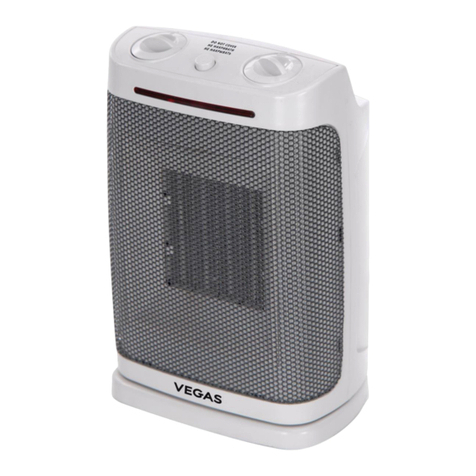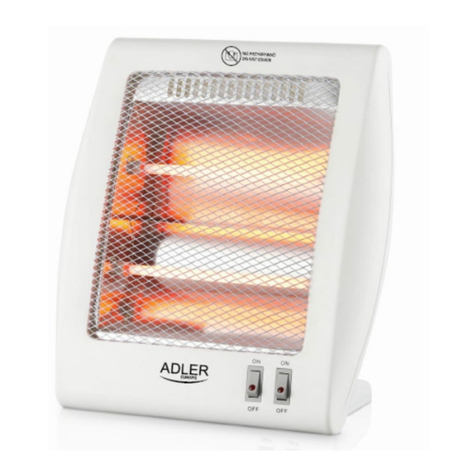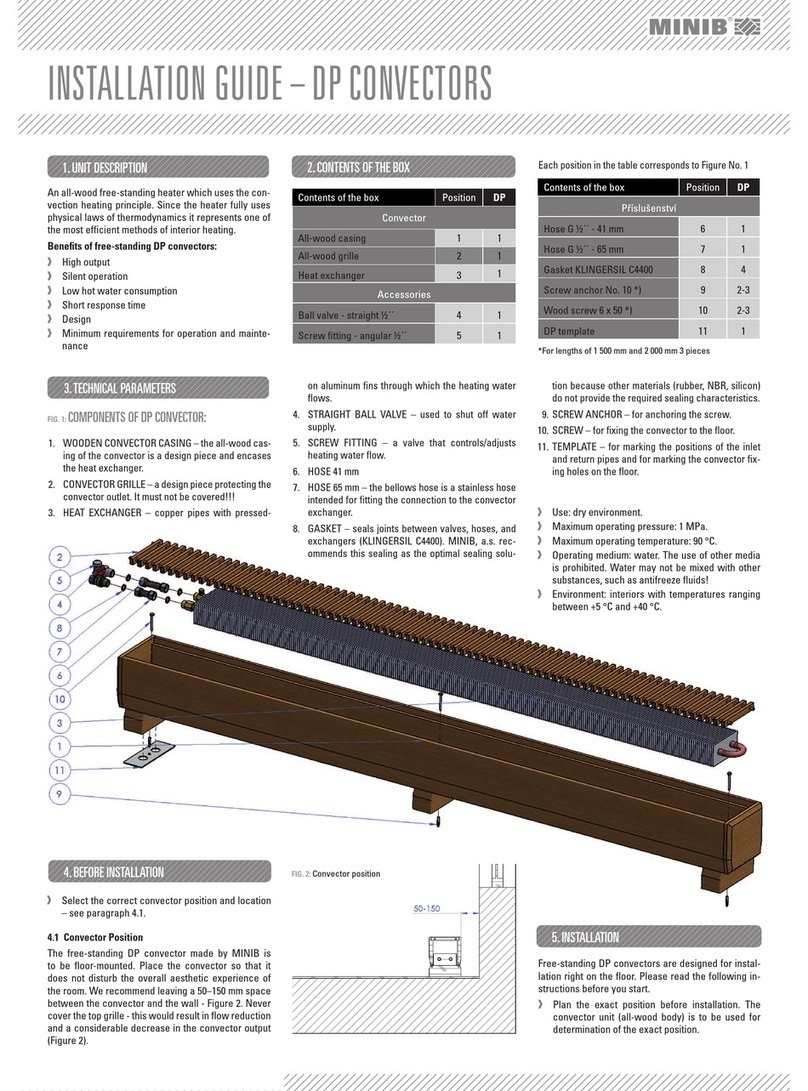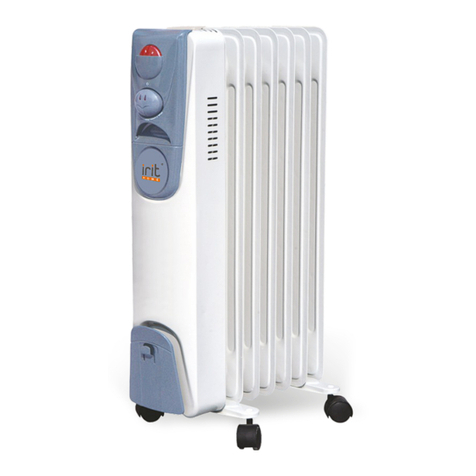Enerzone EB00027 User manual

25-08-2015 45700A
INSTALLATION
AND OPERATION
MANUAL
Destination 2.3
(EB00027 model)
READ AND KEEP THIS MAN AL FOR REFERENCE
www.kfenergy.cz
výrobce: Stove Builder International Inc.
250, De Copenhag e, St-A g stin-de-Desma res (Q ebec) Kanada G3A 2H3
Výhradní distributor: KF gro p s.r.o., Otín 7, Jindřichův Hradec
This manual is available for free download on the manufacturer’s web site. It is a copyrighted
document. Re-sale is strictly prohibited. The manufacturer may update this manual from time to
time and cannot be responsible for problems, injuries, or damages arising out of the use of
information contained in any manual obtained from unauthorized sources.

2
Destination 2.3 Installation and Operation Man al
THANK YO FOR CHOOSING THIS WOOD STOVE
We want to congrat late yo on yo r p rchase and wish to help yo get maxim m satisfaction
from yo r wood stove. In the pages that follow, we will give yo advice on wood heating and
controlled comb stion as well as technical specifications regarding installation, operation and
maintenance of the model yo have chosen.
All local and national reg lations, incl ding those referring to national and E ropean standards,
shall be followed when installing this appliance.
Please read this entire manual before you install and use your new wood stove. Failure to follow
instructions may result in property damage, bodily injury, or even death. It is important that you
follow the installations guidelines exactly.
Consult your local city, borough or shire council about restrictions and installations
requirements in your area and the need to obtain a permit.
KEEP THIS INSTR CTION MAN AL FOR F T RE REFERENCE.

Destination 2.3 Installation and Operation Man al
3
Table of content
PART A - OPERATION AND MAINTENANCE ............................................ 5
1 Safety Information ......................................................................... 5
1.1 S mmary of Operation and Maintenance Ca tions and Warnings ...................................... 5
2 General Information ....................................................................... 6
2.1 Destination 2.3 Specifications ............................................................................................... 6
2.2 Zone Heating and How to Make it Work for Yo .................................................................. 9
2.3 The Benefits of Low Emissions and High Efficiency ............................................................... 9
2.4 Enerzone’s Commitment to Yo and the Environment ........................................................ 9
2.4.1 What is Yo r New Wood stove Made Of? ....................................................................... 10
3 Operating Your Wood Stove ......................................................... 11
3.1 The Use of a Fire Screen. ..................................................................................................... 11
3.2 Yo r First Fires ..................................................................................................................... 11
3.3 Lighting Fires ........................................................................................................................ 11
3.4 Where to store wood .......................................................................................................... 12
3.5 Maintaining Wood Stoves ................................................................................................... 12
3.5.1 General Advice ................................................................................................................. 12
3.5.2 Ash Removal ..................................................................................................................... 13
3.5.3 Raking Charcoal ................................................................................................................ 13
3.5.4 Firing Each New Load Hot ................................................................................................ 14
3.5.5 T rning Down the Air S pply ........................................................................................... 14
3.5.6 B ilding Different Fires for Different Needs .................................................................... 15
4 Maintaining Your Wood Heating System ....................................... 17
4.1 Wood Stove Maintenance ................................................................................................... 17
4.1.1 Cleaning Door Glass ......................................................................................................... 17
4.1.2 Door Adj stment .............................................................................................................. 17
4.1.3 Replacing the Door Gasket ............................................................................................... 18
4.1.4 Replacing the Glass Gasket and/or the Glass .................................................................. 19
4.1.5 Cleaning and Painting the Wood Stove ........................................................................... 20
4.2 Fl e and Fl e System Maintenance ..................................................................................... 20
4.2.1 Why Fl e System Cleaning is Necessary .......................................................................... 20
4.2.2 How Often Sho ld Yo Clean the Fl e System? .............................................................. 20

4
Destination 2.3 Installation and Operation Man al
PART B – INSTALLATION ...................................................................... 21
5 Clearances to Walls and Ceiling .................................................... 21
5.1 Floor protector .................................................................................................................... 23
6 Air Supply in Conventional Houses ................................................ 23
Appendix 1: Reversing the Door Opening and Adjusting the Handle .... 24
Appendix 2: Installing the Optional Decorative Panels ......................... 26
Appendix 3: Installing the Optional Fresh Air Intake Kit ....................... 28
Appendix 4: Installing the Optional Fire Screen (AC01315) .................. 29
Appendix 5: Installation and se of the Blower ................................... 30
Appendix 6: Installation of Secondary Air Tubes and Baffle ................. 31
Appendix 7: Exploded Diagram and Parts List ...................................... 33
ENERZONE LIMITED LIFETIME WARRANTY .......................................... 36

Destination 2.3 Installation and Operation Man al
5
PART A - OPERATION AND MAINTENANCE
Please see Part B for installation instr ctions.
1SAFETY INFORMATION
1.1 S MMARY OF OPERATION AND MAINTENANCE CA TIONS AND WARNINGS
•HOT WHILE IN OPERATION, KEEP CHILDREN, CLOTHING AND F RNIT RE AWAY. CONTACT
MAY CA SE SKIN B RNS. GLOVES MAY BE NEEDED FOR WOOD STOVE OPERATION.
•SING A WOOD STOVE WITH CRACKED OR BROKEN COMPONENTS, S CH AS GLASS OR
FIREBRICKS OR BAFFLES MAY PROD CE AN NSAFE CONDITION AND MAY DAMAGE THE
WOOD STOVE.
•OPEN THE AIR CONTROL F LLY BEFORE OPENING FIRING DOOR.
•THIS WOOD STOVE HAS BEEN TESTED FOR SE WITH AN OPEN DOOR IN CONJ NCTION
WITH A FIRE SCREEN (AC01315, SOLD SEPARATELY). THE DOOR MAY BE OPEN OR FIRE
SCREEN REMOVED ONLY D RING LIGHTING PROCED RES OR RELOADING. ALWAYS CLOSE
THE DOOR OR P T BACK THE FIRE SCREEN AFTER IGNITION. DO NOT LEAVE THE WOOD
STOVE NATTENDED WHEN THE DOOR IS OPENED WITH OR WITHO T FIRE SCREEN.
•NEVER SE GASOLINE, GASOLINE-TYPE LANTERN F EL (NAPHTHA), F EL OIL, MOTOR OIL,
KEROSENE, CHARCOAL LIGHTER FL ID, OR SIMILAR LIQ IDS OR AEROSOLS TO START OR
‘FRESHEN P’ A FIRE IN THIS WOOD STOVE. KEEP ALL S CH LIQ IDS OR AEROSOLS WELL
AWAY FROM THE WOOD STOVE WHILE IT IS IN SE.
•DO NOT SE AS AN INCINERATOR.
•DO NOT CONNECT TO ANY AIR DISTRIB TION D CT OR SYSTEM.
•DO NOT CONNECT THIS NIT TO A CHIMNEY FL E SERVING ANOTHER APPLIANCE.
•DO NOT STORE F EL WITHIN HEATER MINIM M INSTALLATION CLEARANCES.
•SE ONLY RECOMMENDED F EL. B RN ONLY SEASONED NAT RAL FIREWOOD.
•THE SE OF SOME TYPES OF PRESERVATIVE-TREATED WOOD AS A F EL CAN BE HAZARDO S.
•DO NOT B RN:
oGARBAGE OF ANY KIND,
oCOAL OR CHARCOAL,
oTREATED, PAINTED OR COATED WOOD,
oPLYWOOD OR PARTICLE BOARD,
oFINE PAPER, COLORED PAPER OR CARDBOARD,
oSALT WATER DRIFTWOOD, OR
oRAILROAD TIES.
•DO NOT ELEVATE THE FIRE BY SING A GRATE IN THIS WOOD STOVE.
•THIS APPLIANCE SHO LD BE MAINTAINED AND OPERATED AT ALL TIMES IN ACCORDANCE
WITH THESE INSTR CTIONS.

6
Destination 2.3 Installation and Operation Man al
2 GENERAL INFORMATION
2.1 DESTINATION 2.3 SPECIFICATIONS
Recommended f el Wood logs (Birch, Beech or
Hornbeam)
Test Standard EN 13240
Type of comb stion Intermittent
B rn Time* 6 to 8 ho rs
Reload time at nominal heat o tp t 45 min
Color Metallic black
Minim m fl e dra ght 12 Pa
Weight: 247 kg
Firebox Vol me 0,065 m
3
Maxim m Log Length 508 mm
Recommended log length 406 mm
Log loading : Sideways**
Fl e O tlet Diameter 150 mm
Baffle Material C-Cast
Burn time and heating capacity may vary subject to location in home, flue system draft, flue
system diameter, locality, heat loss factors, climate, fuels and other variables.
Sideways: through the door you see the sides of the logs.
Nominal Heat output*
9 kW 16 kW
Fl e gas temperat re 299 °C 373 °C
Efficiency 75,55 % 73,59 %
CO
2
mean concentration 9,79 % 12,23 %
*Val es are witho t the se of a blower. They may vary slightly with the se of this accessory.

Destination 2.3 Installation and Operation Man al
7

8
Destination 2.3 Installation and Operation Man al

Destination 2.3 Installation and Operation Man al
9
2.2 ZONE HEATING AND HOW TO MAKE IT WORK FOR YO
Yo r new Destination 2.3 wood stove is a space heater, which means it is intended to heat the
area it is installed in, as well as spaces that connect to that area, altho gh to a lower temperat re.
This is called zone heating and it is an increasingly pop lar way to heat homes or spaces within
homes.
Zone heating can be sed to s pplement another heating system by heating a partic lar space
within a home, s ch as a basement family room or an addition that lacks another heat so rce.
Ho ses of moderate size and relatively new constr ction can be heated with a properly sized and
located wood stove. Whole ho se zone heating works best when the wood stove is located in the
part of the ho se where the family spends most of its time. This is normally the main living area
where the kitchen, dining and living rooms are located. By locating the wood stove in this area,
yo will get the maxim m benefit of the heat it prod ces and will achieve the highest possible
heating efficiency and comfort. The space where yo spend most of yo r time will be warmest,
while bedrooms and basement (if there is one) will stay cooler. In this way, yo will b rn less wood
than with other forms of heating.
Altho gh the wood stove may be able to heat the main living areas of yo r ho se to an adeq ate
temperat re, we strongly recommend that yo also have a conventional oil, gas or electric heating
system to provide back p heating.
Yo r s ccess with zone heating will depend on several factors, incl ding the correct sizing and
location of the wood stove, the size, layo t and age of yo r home and yo r climate zone. Three-
season vacation homes can s ally be heated with smaller wood stoves than ho ses that are
heated all winter.
2.3 THE BENEFITS OF LOW EMISSIONS AND HIGH EFFICIENCY
The low smoke emissions prod ced by the special feat res inside the Destination 2.3 firebox mean
that yo r ho sehold will release p to 90 percent less smoke into the o tside environment than if
yo sed an older conventional wood stove. B t there is more to the emission control
technologies than protecting the environment.
The smoke released from wood when it is heated contains abo t half of the energy content of the
f el. By b rning the wood completely, yo r wood stove releases all the heat energy from the
wood instead of wasting it as smoke p the fl e system. Also, the feat res inside the firebox allow
yo to red ce the air s pply to control heat o tp t, while maintaining clean and efficient flaming
comb stion, which boosts the efficient delivery of heat to yo r home.
The emission control and advanced comb stion feat res of yo r wood stove can only work
properly if yo r f el is in the correct moist re content range of 15 to 20 percent.
2.4 ENERZONE’S COMMITMENT TO YO AND THE ENVIRONMENT
The Enerzone team is committed to protecting the environment, so we do everything we can to
se only materials in o r prod cts that will have no lasting negative impact on the environment.

10
Destination 2.3 Installation and Operation Man al
2.4.1 WHAT IS YO R NEW WOOD STOVE MADE OF?
The body of yo r wood stove, which is most of its weight, is carbon steel. Sho ld it ever become
necessary many years in the f t re, almost the entire wood stove can be recycled into new
prod cts, th s eliminating the need to mine new materials.
The paint coating on yo r wood stove is very thin. Its VOC content (Volatile Organic Components)
is very low. VOCs can be responsible for smog, so all the paint sed d ring the man fact ring
process meets the latest air q ality req irements with regards to VOC red ction or elimination.
The air t bes are stainless steel, which can also be recycled.
The C-Cast baffle is made of an al minosilicate fibre material that is compressed with a binder to
form a rigid board. C-Cast can withstand temperat res above 1093 °C. It is not considered
hazardo s waste. Disposal at a landfill is recommended.
Firebrick is mainly composed of silicon dioxide, also known as silica, an earth derived prod ct. It is
most commonly fo nd in nat re in the form of sand and clay. Disposal at a landfill is
recommended.
The door and glass gaskets are fibreglass which is sp n from melted sand. Black gaskets have been
dipped into a solvent-free sol tion. Disposal at a landfill is recommended.
The door glass is a 5 mm thick ceramic material that contains no toxic chemicals. It is basically
made of raw earth materials s ch as sand and q artz that are combined in s ch a way to form a
glass at high temperat res. Ceramic glass will not re-melt in the same way as normal glass, so it
sho ld not be recycled with yo r reg lar ho sehold prod cts. Disposal at a landfill is
recommended.

Destination 2.3 Installation and Operation Man al
11
3OPERATING YO R WOOD STOVE
•NEVER OVERFIRE YO R WOOD STOVE. IF ANY PART OF THE WOOD STOVE STARTS TO GLOW
RED, OVER FIRING IS HAPPENING. READJ ST THE AIR INTAKE CONTROL AT A LOWER
SETTING.
•NEVER LOAD YO R WOOD STOVE P TO THE BAFFLE. ALWAYS LEAVE 5 TO 10 CENTIMETERS
TO ALLOW PROPER COMB STION THRO GH SECONDARY AIR OPENINGS (NEVER P T WOOD
ABOVE THE FIREBRICK LINING ON THE FIREBOX). THIS WILL ALSO PREVENT OVERFIRING OF
YO R WOOD STOVE.
•SHO LD THERE BE A SOOT OR CREOSOTE FIRE IN YO R FL E SYSTEM ALSO CALLED CHIMNEY
FIRE, CLOSE THE AIR CONTROL COMPLETELY. IMMEDIATELY CALL THE FIRE DEPARTMENT.
•
3.1 THE SE OF A FIRE SCREEN.
This wood stove has been tested for se with an open door in conj nction with a fire screen
(AC01315, sold separately). Make s re the fire screen is properly sec red on the wood stove to
avoid any risk of fire. When the fire screen is sed, it is important not to leave the wood stove
nattended to respond promptly in the event of smoke spillage into the room. See Appendix 4:
Installing the Fire Screen (AC01315) for installation instr ctions.
3.2 YO R FIRST FIRES
Two things will happen as yo b rn yo r first few fires; the paint c res and the internal
components of the wood stove are conditioned.
As the paint c res, some of the chemicals vaporize. The vapors are not poisono s, b t they do
smell bad. Fresh paint f mes can also ca se false alarms in smoke detectors. So, when yo first
light yo r wood stove, be prepared by opening doors and/or windows to ventilate the ho se. As
yo b rn hotter and hotter fires, more of the painted s rfaces reach the c ring temperat re of the
paint. The smell of c ring paint does not disappear ntil yo have b rned one or two very hot
fires.
B rn one or two small fires to begin the c ring and conditioning process. Then b ild bigger and
hotter fires ntil there is no longer any paint smell from the wood stove. Once the paint smell
disappears, yo r wood stove is ready for serio s heating.
3.3 LIGHTING FIRES
Each person who heats with wood develops their own favorite way to light fires. Whatever
method yo choose, yo r goal sho ld be to get a hot fire b rning q ickly. A fire that starts fast
prod ces less smoke and deposits less creosote in the fl e system.

12
Destination 2.3 Installation and Operation Man al
3.4 WHERE TO STORE WOOD
This stove has been certified to store logs in the pedestal provided that the following req irements
are met:
•
The logs m st not exceed the inside edge
(A) of the pedestal.
•The heat shield baffle (B) nder the firebox
m st never be removed.
•No comb stible material can be placed
above the heat shield baffle.
3.5 MAINTAINING WOOD STOVES
3.5.1 GENERAL ADVICE
Wood heating with a space heater is very different than other forms of heating. There will be
variations in the temperat re in different parts of the ho se and there will be variations in
temperat re thro gho t the day and night. This is normal, and for experienced wood b rners
these are advantages of zone heating with wood.
Do not expect steady heat o tp t from yo r wood stove. It is normal for its s rface temperat re
to rise after a new load of wood is ignited and for its temperat re to grad ally decline as the fire
progresses. This rising and falling of temperat re can be matched to yo r ho sehold ro tines. For
example, the area temperat re can be cooler when yo are active, s ch as when doing ho sework
or cooking, and it can be warmer when yo are inactive, s ch as when reading or watching
television.
Wood b rns best in cycles. A cycle starts when a new load of wood is ignited by hot coals and ends
when that load has been cons med down to a bed of charcoal abo t the same size as it was when
the wood was loaded. Do not attempt to prod ce a steady heat o tp t by placing a single log on
the fire at reg lar intervals. Always place at least three, and preferably more, pieces on the fire at
a time so that the heat radiated from one piece helps to ignite the pieces next to it. Each load of
wood sho ld provide several ho rs of heating. The size of each load can be matched to the
amo nt of heat needed.

Destination 2.3 Installation and Operation Man al
13
When yo b rn in cycles, yo rarely need to open the wood stove’s loading door while the wood is
flaming. This is an advantage beca se there is more chance that smoke will leak from the wood
stove when the door is opened as a f ll fire is b rning. This is especially tr e if the fl e connector
has 90 degree elbows and if the fl e system r ns p the o tside wall of the ho se.
IF YO M ST OPEN THE DOOR WHILE THE F EL IS FLAMING, OPEN THE AIR CONTROL F LLY FOR
A FEW MIN TES, THEN NLATCH AND OPEN THE DOOR SLOWLY.
3.5.2 ASH REMOVAL
Ash sho ld be removed from the firebox every two or three days of f ll time heating. Do not let
the ash b ild p in the firebox beca se it will interfere with proper fire management.
The best time to remove ash is after an overnight fire when the wood stove is relatively cool, b t
there is still some fl e system draft to draw the ash d st into the wood stove and prevent it from
coming into the room.
After ashes have been removed from the wood stove and placed in a tightly covered container
made of non-comb stible material, they sho ld be taken o tside immediately. The closed
container of ashes sho ld be placed on a non-comb stible floor or on the gro nd well away from
all comb stible materials pending final disposal. Ashes normally contain some live charcoal that
can stay hot for several days. If the ashes are disposed of by b rial in soil or otherwise locally
dispersed, they sho ld be retained in the closed container ntil all cinders have thoro ghly cooled.
Other waste shall not be placed in this container.
NEVER STORE ASHES INDOORS OR IN A CONTAINER MADE OF COMB STIBLE MATERIAL OR ON
A WOODEN DECK.
KEEP ASH DOOR CLOSED EXCEPT D RING IGNITION, REF ELLING AND REMOVAL OF RESID E
MATERIAL TO PREVENT F ME SPILLAGE.
3.5.3 RAKING CHARCOAL
Rekindle the fire when yo notice that the room temperat re has fallen. Yo will find most of the
remaining charcoal at the back of the firebox, f rthest from the door. Rake these coals towards
the door before loading. There are two reasons for this raking of the coals. First, it concentrates
them near where most of the comb stion air enters the firebox and where they can ignite the new
load q ickly, and second, the charcoal will not be smothered by the new load of wood. If yo were
to simply spread the charcoal o t, the new load will smo lder for a long time before igniting.
Remove ash first, and then rake charcoal towards the front of the firebox before loading so that it
will ignite the new load.

14
Destination 2.3 Installation and Operation Man al
3.5.4 FIRING EACH NEW LOAD HOT
Place the new load of wood on and behind the charcoal and not too close to the glass. Close the
door and open the air control f lly. Leave the air control f lly open ntil the firebox is f ll of
flames, the wood has charred to black and its edges are glowing red. Firing each load of wood hot
accomplishes a few things:
•drives the s rface moist re from the wood,
•creates a layer of char on the wood, which slows down its release of smoke,
•heats the firebox components so they reflect heat back to the fire, and
•heats the fl e system so it can prod ce strong, steady draft for the rest of the cycle.
Altho gh it is important to fire each new load hot to prepare for a clean b rn, do not allow the fire
to b rn at f ll intensity for more than a few min tes.
DO NOT LEAVE THE WOOD STOVE NATTENDED WHILE A NEW LOAD IS BEING FIRED HOT.
When yo b rn a new load of wood hot to heat p the wood, the wood stove and the fl e system,
the res lt will be a s rge of heat from the wood stove. This heat s rge is welcome when the room
temperat re is a little lower than desirable, b t not welcome if the space is already warm.
Therefore, allow each load of wood to b rn down so that the space begins to cool off a little
before loading. Letting the space cool before loading is one of the secrets to clean b rning and
effective zone heating.
3.5.5 T RNING DOWN THE AIR S PPLY
Once the firewood, firebox and fl e system are hot, yo can begin to red ce the air s pply for a
steady b rn.
As yo red ce the air s pply to the fire, two important things happen. First, the firing rate slows
down to spread the heat energy in the f el over a longer period of time. Second, the flow rate of
exha st thro gh the wood stove and fl e slows down, which gives more time for the transfer of
heat from the exha st. Yo will notice that as yo red ce the air setting, the flames slow down.
This is yo r indication that the wood stove is b rning at its peak efficiency.
If the flames get small and almost
disappear when yo t rn down the air,
yo have t rned down the air too early, or
yo r firewood is wetter than it sho ld be.
With good f el and correct air control se,
the flames sho ld slow down, b t sho ld
stay large and steady, even as the air
s pply is red ced.

Destination 2.3 Installation and Operation Man al
15
3.5.6 B ILDING DIFFERENT FIRES FOR DIFFERENT NEEDS
Using the air control is not the only way to match the wood stove’s heat o tp t to the heat
demand. Yo r ho se will need far less heat in October than in Jan ary to be kept at a comfortable
temperat re. If yo fill the firebox f ll in fall weather, yo will either overheat the space or t rn
the wood stove down so m ch that the fire will be smoky and inefficient. Here are some
s ggestions for b ilding fires to match different heat demand.
3.5.6.1 Small Fires to Take the Chill Off the ouse
To b ild a small fire that will prod ce a low heat o tp t, se small pieces of firewood and load
them crisscross in the firebox. The pieces sho ld be only 75 mm to 100 mm in diameter. After
raking the coals, yo can lay two pieces parallel to each other corner to corner in the firebox and
lay two more across them in the other direction. Open the air control f lly and only red ce the air
after the wood is f lly flaming. This kind of fire is good for mild weather when yo are aro nd to
tend the wood stove and sho ld provide eno gh heat for fo r ho rs or more. Small fires like this
are a good time to se softer wood species so there will be less chance of overheating the ho se.
3.5.6.2 Long Lasting Low Output Fires
Sometimes yo will want to b ild a fire to last p to eight ho rs, b t don’t need intense heat. In
this case se smaller pieces of hardwood and place the logs compactly in the firebox so the pieces
are packed tightly together. Yo will need to fire the load hot for long eno gh to f lly char the log
s rfaces before yo can t rn the air down. Make s re the fire is flaming brightly before leaving the
fire to b rn.
3.5.6.3 igh Output Fires for Cold Weather
When the heat demand is high d ring cold weather, yo ’ll need a fire that b rns steadily and
brightly. This is the time to se yo r biggest pieces of hardwood f el if yo have it. P t the biggest
pieces at the back of the firebox and place the rest of the pieces compactly. A densely b ilt fire like
this will prod ce the longest b rn yo r wood stove is capable of.
Yo will need to be ca tio s when b ilding fires like this beca se if the air is t rned down too
m ch, the fire co ld smo lder. Make s re the wood is flaming brightly before leaving the fire to
b rn. The wood sho ld be positioned in a north/so th fashion, that is, from the front to the back
of the firebox.

16
Destination 2.3 Installation and Operation Man al
3.5.6.4 Maximum Burn Cycle Times
The b rn cycle time is the period between loading wood on a coal bed and the cons mption of
that wood back to a coal bed of the same size. The flaming phase of the fire lasts for ro ghly the
first half of the b rn cycle and the second half is the coal bed phase d ring which there is little or
no flame. The length of b rn yo can expect from yo r wood stove, incl ding both the flaming and
coal bed phases, will be affected by a n mber of things, s ch as:
•firebox size,
•the amo nt of wood loaded,
•the species of wood yo b rn,
•the wood moist re content,
•the size of the space to be heated,
•the climate zone yo live in, and
•the time of year.
The table below provides a very general indication of the maxim m b rn cycle times yo are likely
to experience, based on firebox vol me.
FIREBOX VOL ME MAXIM M B RN TIME
< 0.042 c bic meter 3 to 5 ho rs
0.042 m
3
to 0.056 m
3
5 to 6 ho rs
0.056 m
3
to 0.071 m
3
6 to 8 ho rs
0.071 m
3
to 0.085 m
3
8 to 9 ho rs
> 0.085 m
3
9 to 10 ho rs
Long b rn times are not necessarily an indication of efficient wood stove operation. When yo are
home d ring the day and able to tend the fire, it is preferable to b ild a smaller fire that might
provide three or fo r ho rs of heating than to f lly load the firebox for a m ch longer b rn.
Shorter b rn cycles make it easier to match the heat o tp t of the wood stove to the heat demand
of the space.

Destination 2.3 Installation and Operation Man al
17
4MAINTAINING YO R WOOD HEATING SYSTEM
Keep in mind when installing yo r wood stove that there is a need to keep eno gh space aro nd
the roomheater to be able to perform all req ired maintenance.
Maintenance sho ld be performed by a competent engineer.
4.1 WOOD STOVE MAINTENANCE
Yo r new wood stove will give many years of reliable service if yo se and maintain it correctly.
Some of the internal components of the firebox, s ch as firebricks, baffles and air t bes, will wear
over time nder intense heat. Yo sho ld always replace defective parts with original parts (see
Appendix 7: Exploded Diagram and Parts List). For firing each load hot to begin a cycle as
described above will not ca se premat re deterioration of the wood stove. However, letting the
wood stove r n with the air control f lly open for entire cycles can ca se damage over time. The
hotter yo r n the wood stove thro gho t b rn cycles, the more q ickly its components will
deteriorate. For that reason, never leave the wood stove unattended while a new load is being
fired hot.
4.1.1 CLEANING DOOR GLASS
Under normal conditions, yo r door glass sho ld stay relatively clear. If yo r firewood is dry
eno gh and yo follow the operating instr ctions in this man al, a whitish, d sty deposit will form
on the inside of the glass after a week or so of se. This is normal and can be easily removed when
the wood stove is cool by wiping with a damp cloth or paper towel and then drying. Never try to
clean the glass when the wood stove is hot.
In spring and fall when the wood stove is r n at lower temperat res, yo may see some light
brown stains forming, especially at the lower corners of the glass. This indicates that the fire has
been smoky and some of the smoke has condensed on the glass. When the weather is mild, yo
may find that letting the fire go o t is better than trying to maintain a contin o s fire. Use the
techniq e described above for b ilding a fire to take the chill off the ho se.
If yo do get brown stains on the glass yo can remove them with special cleaners for wood stove
glass doors. Do not use abrasives to clean your wood stove’s door glass.
The deposits that form on the glass are the best indication of the q ality of yo r f el and how well
yo are doing in operating the wood stove. Yo r goal sho ld be clear glass with no brown stains. If
yo contin e to see brown stains on the glass, something abo t yo r f el and operating proced re
needs to be changed. Stains on the glass indicate incomplete comb stion of the wood, which also
means more smoke emissions and faster formation of creosote in the fl e system.
If yo see brown streaks coming from the edge of the glass, it is time to replace the gasket aro nd
the glass. Visit yo r wood stove retailer to get the self-adhesive glass gasket and follow the
instr ctions of Section 4.1.4 for installation.
4.1.2 DOOR ADJ STMENT
In order for yo r stove to b rn at its best efficiency, the door m st provide a perfect seal with the
firebox. Therefore, the gasket sho ld be inspected periodically making s re to obtain an air tight
fit. Air tightness can be improved with a simple latch mechanism adj stment. To increase the

18
Destination 2.3 Installation and Operation Man al
press re on the gasket, remove one washer (B). To red ce press re on the door, when p tting a
new door gasket for example, p t two washers. To adj st:
1. Unscrew the two screws (A) and
remove/add one spacer (B).
2. Reinstall the latch with the screws
(A).
4.1.3 REPLACING THE DOOR GASKET
It is important to maintain the gasket in good condition. After a year or more of se, the door
gasket will compress and become hard, which may allow air to leak past it. Yo can test the
condition of the door gasket by closing and latching the door on a strip of paper. Test all aro nd
the door. If the paper slips o t easily anywhere, it is time to replace the gasket.
Use the correct replacement gasket that yo can p rchase from yo r retailer. The diameter and
density of the gasket is important to getting a good seal.
Place the door face-down on something soft like a c shion of rags or piece of carpet. Remove the
old gasket from the door by p lling and prying it o t with an old screw driver. Then se the
screwdriver to scrape the old gasket adhesive from the door. Now r n a 6 mm bead of high
temperat re silicone in the door gasket groove. Starting from the middle of the hinge side, press
the gasket into the groove. Do not stretch the gasket as yo place it. Leave the gasket abo t 12
mm long when yo c t it and press the end into the groove. T ck any loose fibres nder the gasket
and into the silicone. Close the door and do not se the wood stove for 24 ho rs.

Destination 2.3 Installation and Operation Man al
19
4.1.4 REPLACING THE GLASS GASKET AND/OR THE GLASS
It is a good idea to replace the glass gasket when the door gasket is replaced. The gasket is flat,
adhesive-backed, woven fibreglass. Remove the glass retaining screws and clips. Lift o t the glass
and p ll off the old gasket. This is a good time to clean the glass thoro ghly.
The gasket m st be centred on the edge of the glass. To do this easily, peel back a section of the
paper covering the adhesive and place the gasket on a table with the adhesive side p. Stick the
end of the gasket to the middle of one edge, then press the edge of the glass down onto the
gasket, taking care that it is perfectly centred on the gasket. Peel off more of the backing and
rotate the glass and press the next section onto the gasket. Do not stretch the gasket as yo place
it. Contin e ntil yo get to the start and trim the gasket to length. Now pinch the gasket to the
glass in a U shape, all aro nd the glass. Reinstall the glass, being caref l to centre the glass
caref lly in the door. Do not over-tighten the screws. Note that the two main ca ses of broken
door glass are neven placement in the door and over-tightening of retaining screws.
Do not ab se the glass door by striking or slamming sh t. DO NOT SE THE WOOD STOVE IF THE
GLASS IS BROKEN. To change the glass, perform the same operation described above.
It is a good idea to replace the glass gasket
when the door gasket is replaced. The
gasket is flat, adhesive-backed, woven
fibreglass. Remove the glass retaining
screws (A) and clips (B) then both metal
frames (C) that hold the glass to the door
frame (E). Lift o t the glass (D) and p ll off
the old gasket. This is a good time to clean
the glass thoro ghly.

20
Destination 2.3 Installation and Operation Man al
4.1.5 CLEANING AND PAINTING THE WOOD STOVE
Do not attempt to clean or paint the wood stove when the unit is hot. Painted s rfaces can be
wiped down with a damp cloth. Plated s rfaces may be scratched by abrasive cleaners. To
maintain the finish at its original brilliance, se only a damp soft cloth to clean plated s rfaces.
If the paint becomes scratched or damaged, yo can give yo r wood stove a brand new look by
repainting it with heat-resistant paint. Before painting, ro ghen the s rface with fine sand paper,
wipe it down to remove d st, and apply two thin coats of paint. For best res lts, se the same
paint that was originally sed on the wood stove, which is available in spray cans. See yo r dealer
for details.
4.2 FL E AND FL E SYSTEM MAINTENANCE
Yo need to keep eno gh space aro nd the chimney in order to easily access it to do the req ired
maintenance.
4.2.1 WHY FL E SYSTEM CLEANING IS NECESSARY
Wood smoke can condense inside the fl e and fl e system, forming a comb stible deposit called
creosote. If creosote is allowed to b ild p in the fl e system it can ignite when a hot fire is b rned
in the wood stove and a very hot fire can progress to the top of the fl e system. Severe fl e
system fires can damage even the best fl e systems. Smo ldering, smoky fires can q ickly ca se a
thick layer of creosote to form. When yo avoid smo ldering so the exha st from the fl e system
is mostly clear, creosote b ilds p more slowly. Yo r new wood stove has the right characteristics
to help yo to b rn clean fires with little or no smoke, res lting in less creosote in the fl e system.
4.2.2 HOW OFTEN SHO LD YO CLEAN THE FL E SYSTEM?
It is not possible to predict how m ch or how q ickly creosote will form in yo r fl e system. It is
important, therefore, to check the b ild- p in yo r fl e system monthly when getting sed to the
new wood stove ntil yo determine the rate of creosote formation. Even if creosote forms slowly
in yo r system, the fl e system sho ld be cleaned and inspected at least once each year. It is
partic larly important to check for blockage prior to re-lighting after a prolonged sh t down
period.
Contact yo r local m nicipal or provincial fire a thority for information on how to handle a fl e
system fire. Have a clearly nderstood plan to handle a fl e system fire.
Table of contents
Popular Heater manuals by other brands

Thermaltake
Thermaltake Riing Plus 12 installation guide
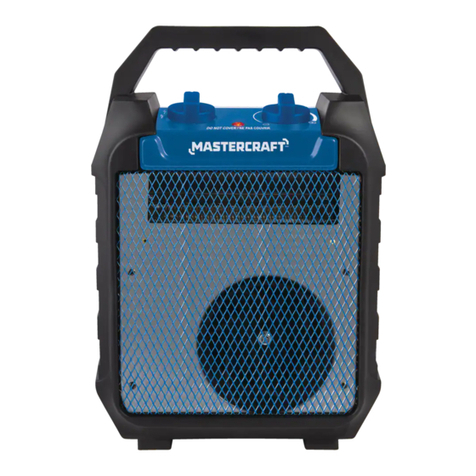
MasterCraft
MasterCraft 043-8407-4 instruction manual

IRSAP
IRSAP 987M1220 manual
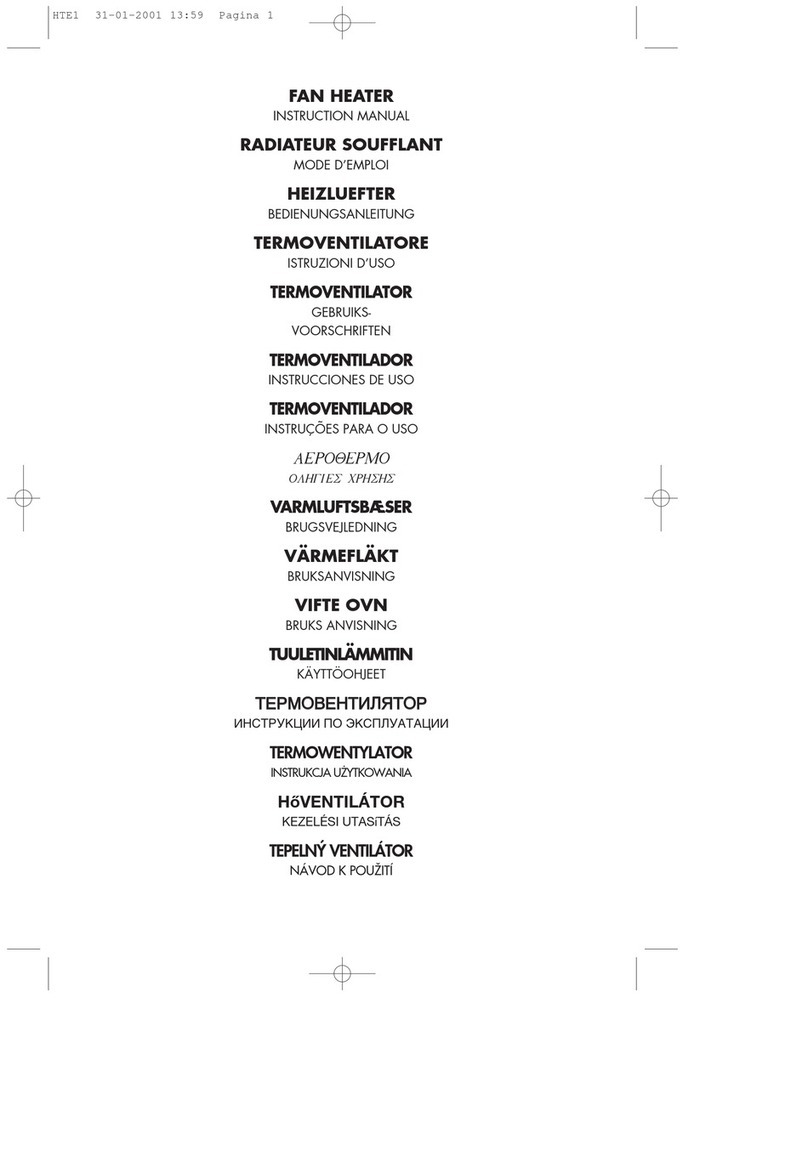
DeLonghi
DeLonghi HTE Series instruction manual

Harbor Freight Tools
Harbor Freight Tools 90553 operating instructions
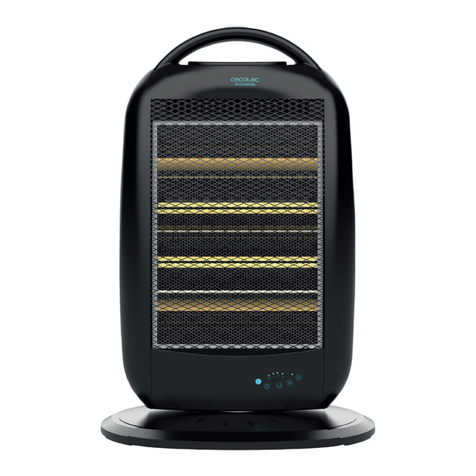
cecotec
cecotec Ready Warm 7200 Quartz Rotate Smart instruction manual
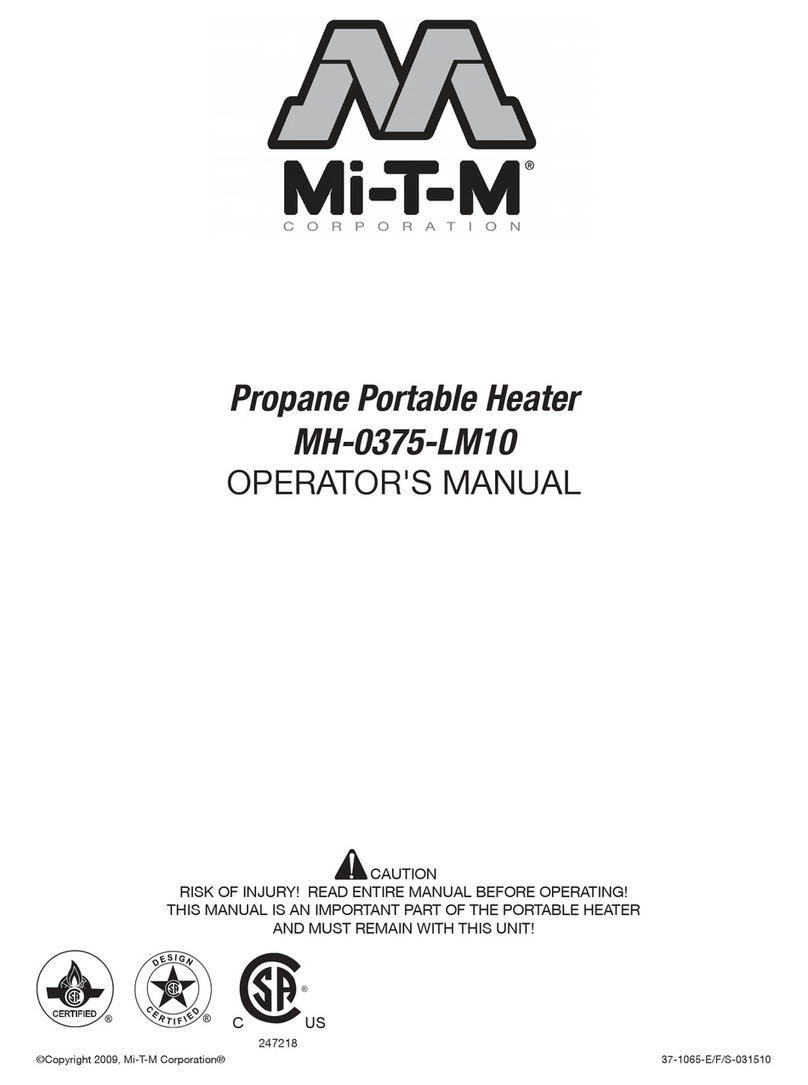
Mi-T-M
Mi-T-M MH-0375-LM10 Operator's manual
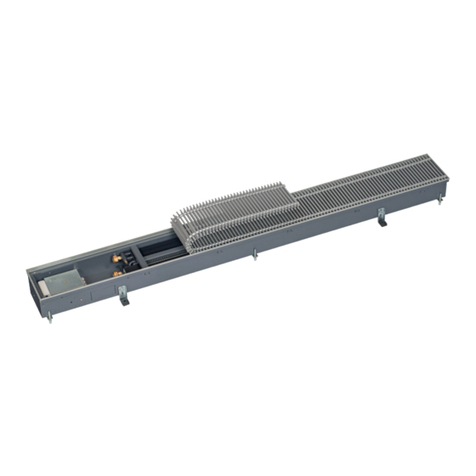
Kampmann
Kampmann Katherm QK 190 Assembly, installation and operating instructions
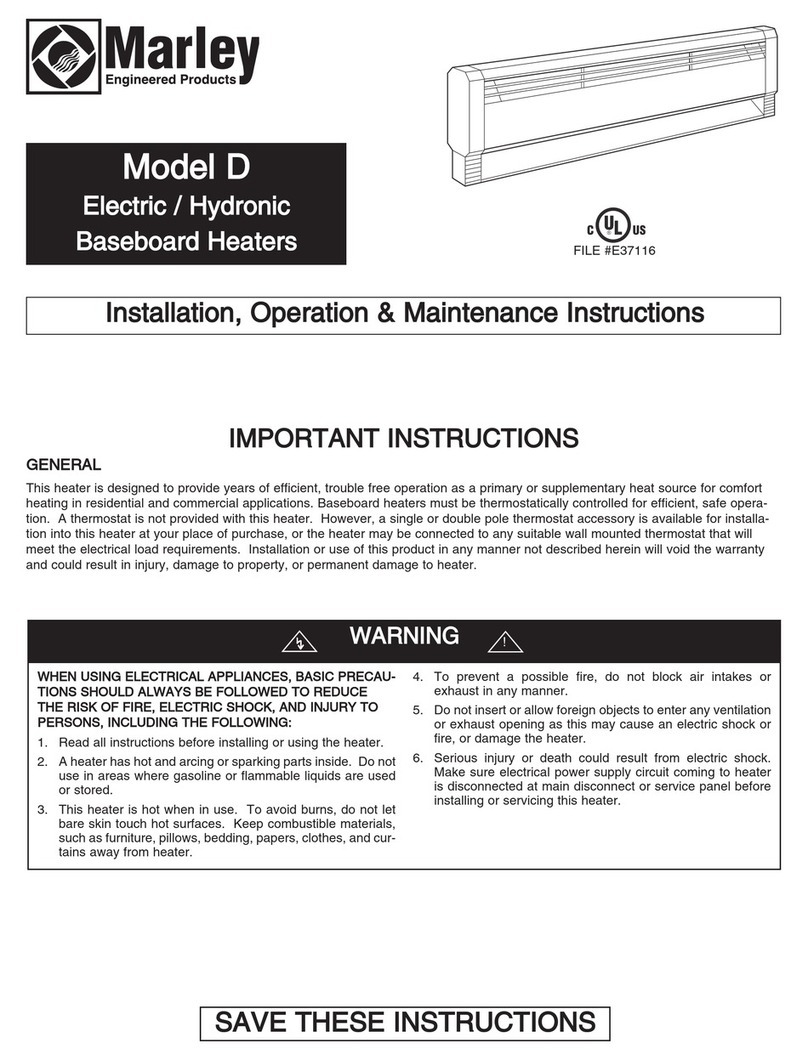
Marley
Marley D Installation, operation & maintenance instructions

Sawotec
Sawotec ARI WALL HEATER ARI3-45NB WL manual

Berko
Berko CPLAS Installation, operation & maintenance instructions
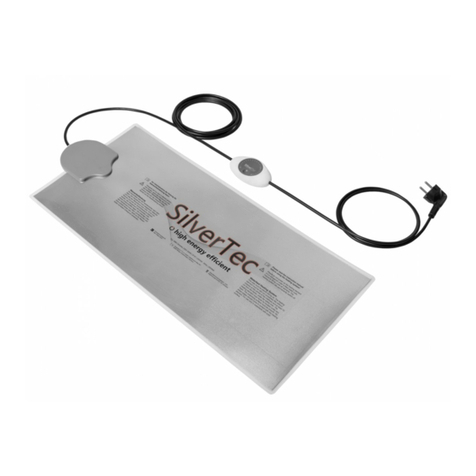
SilverTec
SilverTec WBH operating instructions
